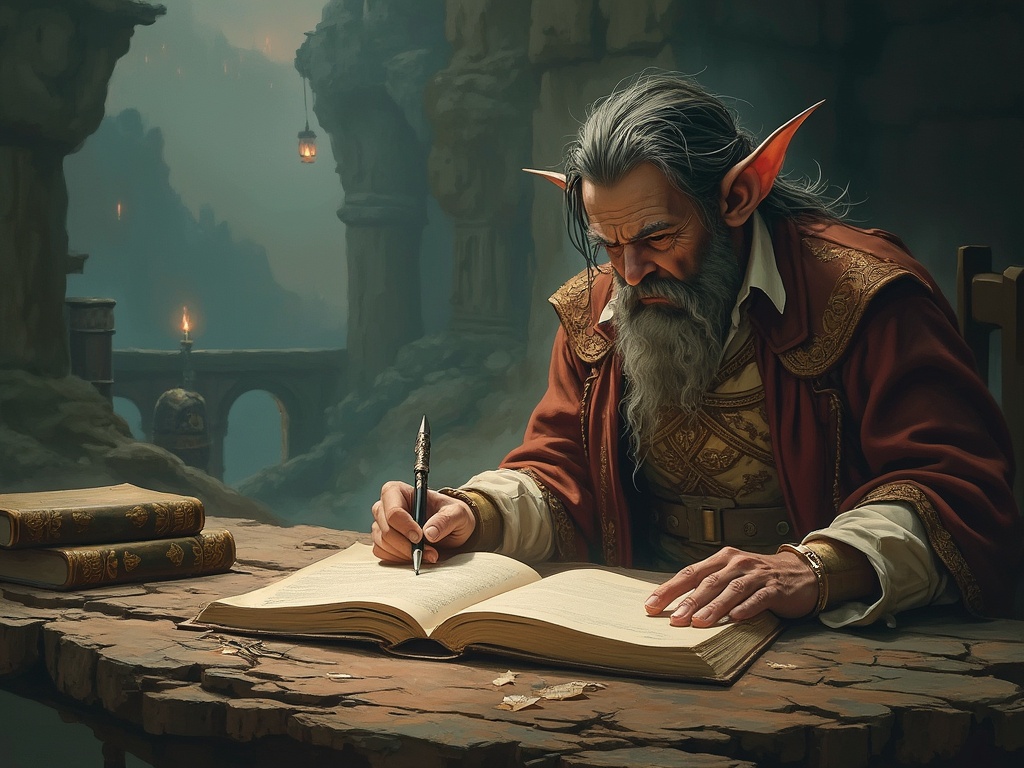Embarking on a fantasy novel journey requires understanding both genre-specific elements and foundational writing principles to craft compelling worlds and characters. The blend of worldbuilding, character development, and structured plotting creates the backbone for fantasy stories that captivate readers and transport them to extraordinary realms beyond imagination.
Key Takeaways
- Successful fantasy novels balance familiar genre elements with innovative concepts that stand out in the market
- Creating consistent magic systems with clear limitations provides structure to your fantasy world
- Using established story frameworks helps organize complex fantasy narratives for maximum impact
- Developing distinctive characters with unique motivations drives engagement in fantasy storytelling
- Regular writing habits and strategic revision processes are essential for completing your fantasy novel
Finding Your Fantasy Audience and Market Position
Before diving into writing a fantasy novel, I need to understand who will read it. Fantasy readers span various demographics, from young adults craving coming-of-age adventures to mature readers seeking complex political intrigue. The fantasy genre has numerous subgenres—epic, urban, dark, romantic—each with dedicated fan bases and expectations.
I should research current bestsellers like Outlander or The Expanse to identify marketable trends without copying them directly. This research helps position my work within the market while highlighting what makes my story unique. Finding the sweet spot between familiar tropes that readers love and original concepts that make my work stand out is crucial.
Tools like Amazon Best Sellers and Publisher’s Weekly offer valuable insights into subgenre popularity and reader preferences. I can track which fantasy elements are trending and which might be oversaturated. Fantasy writing communities on Reddit, Discord, or Facebook also provide real-time feedback on what readers currently crave in the genre.
Building Immersive Fantasy Worlds
The cornerstone of compelling fantasy fiction is immersive worldbuilding. Creating consistent magic systems with clear limitations, like Allomancy in Mistborn or The Force in Star Wars, gives readers something fascinating yet understandable to grasp onto. These systems need rules—what’s possible, what costs are involved, and what limitations exist.
Beyond magic, I need to establish distinctive political structures, cultural norms, and societal hierarchies that feel authentic. These elements shouldn’t just be background decoration but should actively shape character motivations and plot developments. The most engaging fantasy worlds have “rules” that naturally generate conflicts—restricted magic users, class divisions, or territorial disputes.
To manage the complexity of worldbuilding, I can use tools that build story worlds from scratch, including spreadsheets or specialized world bible software. Rather than explaining how magic works through exposition, I should show a character struggling with spell limitations during a critical moment—this demonstrates the rules while maintaining narrative momentum.
Plotting Your Fantasy Adventure
Fantasy novels benefit from structured storytelling frameworks that organize their complex elements. The Hero’s Journey or 9-Point Structure provides proven templates to arrange key events and character developments. These frameworks help ensure my story has proper pacing and emotional beats.
The most compelling fantasy stories layer external conflicts (saving the kingdom) with internal character struggles (overcoming fear, finding identity). This dual-conflict approach creates deeper emotional stakes and more satisfying resolutions. Including a critical “dark moment” where all seems lost heightens emotional impact before the climactic resolution.
The Hourglass Method can help with initial plotting—starting with broad exploration of ideas before narrowing to core conflicts and then expanding again into resolution and consequences. For productivity during drafting, focused 25-minute writing sprints help draft key scenes without overthinking details.
Crafting Memorable Fantasy Characters
Characters drive reader engagement in fantasy novels. Each character needs a unique motivation and personal growth arc that evolves throughout the story. These motivations should connect to both the main plot and the character’s personal history within the fantasy world.
Creating distinctive dialogue patterns that reflect background and personality helps characters feel authentic and memorable. A character raised in an isolated mountain kingdom should speak differently than one from a cosmopolitan trading port. The protagonist’s decisions must actively drive the plot forward rather than simply reacting to events.
Developing contrasting traits adds complexity—the compassionate assassin or the cowardly warrior creates interesting contradictions that readers find compelling. Character exercises like conducting “interviews” by writing responses to prompts like “What’s your greatest fear?” help develop three-dimensional personalities that leap off the page.
Fantasy Novel Outlining Strategies
When learning how to write a fantasy novel outline, I need to choose between detailed planning or discovery writing (“pantsing”). Both approaches can work, but fantasy’s complexity often benefits from some level of planning. The Universal Novel Outline with its three-act structure provides a solid foundation for arranging key story beats.
Creating a “guiding document” to track timelines, character connections, and magic rules keeps complex fantasy elements consistent. A premise document answering core questions about conflict, theme, and resolution helps maintain focus during drafting. AI outlines can be surprisingly helpful for exploring plot possibilities.
Mapping key turning points using the 9-Point Structure—opening image, inciting incident, midpoint shift, climax, and resolution—creates a roadmap for the writing process. This structure ensures proper pacing and emotional progression throughout the fantasy narrative.
Establishing Productive Writing Habits
For those learning how to write a fantasy novel for beginners, establishing consistent writing habits is essential. Setting achievable daily word count goals (500-1,000 words) builds momentum without causing burnout. Remember that completing a fantasy novel is a marathon, not a sprint.
Embracing “messy” first drafts with placeholders for details helps maintain momentum. I can mark sections with [RESEARCH LATER] or [EXPAND MAGIC DESCRIPTION] to keep moving forward rather than getting stuck on perfecting every detail. Creating an optimal writing environment with minimal distractions supports consistent progress.
Organizational tools like Scrivener help manage complex fantasy narratives by keeping worldbuilding notes, character profiles, and draft chapters organized. Many successful fantasy authors launched their careers during National Novel Writing Month with its 50,000-word challenge, proving that focused effort can produce remarkable results.
Revising Your Fantasy Manuscript
Revision is where good fantasy becomes great. Implementing a multi-pass revision strategy allows focusing on different aspects in each round—structure first, then character consistency, and finally language refinement. This approach prevents feeling overwhelmed by trying to fix everything at once.
Recruiting beta readers familiar with fantasy conventions helps identify worldbuilding inconsistencies or places where magic systems feel confusing. For complex fantasy manuscripts, professional developmental editing can provide valuable guidance on genre-specific elements. Creating a revision checklist targeting common fantasy issues like magic system consistency and exposition balance makes the process more manageable.
The most efficient revision approach addresses structural issues first, then character consistency, and finally language—trying to perfect prose too early wastes effort on sections that might get cut. Technology can help craft story arcs during this revision process, ensuring emotional beats land properly.
Writing Captivating Fantasy Prologues
A great prologue can set the stage for an epic fantasy adventure. The best fantasy prologues hook readers with immediate action or intriguing mystery rather than exposition dumps. They establish stakes and themes that will resonate throughout the novel while giving readers a taste of the world’s flavor.
Using rich sensory details to immerse readers in your fantasy world from the first paragraph creates an immediate connection. A fantasy novel can benefit from a standalone vignette showing a pivotal historical moment or prophecy that frames the main story. For example, A Game of Thrones opens with a haunting encounter with supernatural White Walkers, establishing the existential threat before introducing political conflicts.
A fantasy novel title generator can help create compelling book titles that hint at the prologue’s mysteries and the broader story to come. The prologue should raise questions that the reader is eager to have answered, creating a bridge into chapter one while setting appropriate expectations for the story’s tone and themes.
Publishing Your Fantasy Novel
Once my manuscript is polished, I need to evaluate publishing paths based on my goals—traditional publishing versus self-publishing. Each route has advantages for fantasy authors, with traditional publishing offering wider distribution and self-publishing providing creative control and higher royalty percentages.
Building a genre-specific author platform with fantasy-focused content helps connect with potential readers before publication. A fantasy story generator might create sample content for marketing purposes or help develop side stories set in my world. Optimizing book descriptions with targeted fantasy keywords improves discoverability on online platforms.
Studying marketing strategies of successful fantasy debuts in my specific subgenre provides valuable insights. Creating content that appeals to fantasy readers—worldbuilding breakdowns, character art, or magic system explanations—can build an audience before publication, giving my novel the best chance for success in a competitive market.
This comprehensive guide to fantasy novel writing covers essential elements for beginners and experienced writers alike. The article emphasizes balancing familiar genre elements with innovative concepts while creating consistent magic systems with clear limitations. It highlights the importance of structured storytelling frameworks, distinctive character development, and immersive worldbuilding to craft compelling narratives. Practical advice includes researching market positioning, establishing productive writing habits, implementing strategic revision processes, and evaluating publishing options. Throughout, the guide stresses that successful fantasy combines external conflicts with internal character struggles to create deeper emotional stakes.
| Key Aspect | Main Point |
|---|---|
| Market Positioning | Research current trends to find balance between familiar tropes and original concepts |
| Worldbuilding | Create consistent magic systems with clear rules and limitations |
| Plot Structure | Use frameworks like Hero’s Journey to organize complex narratives |
| Character Development | Craft characters with unique motivations that drive plot advancement |
| Writing Process | Establish consistent habits and embrace multi-stage revision |



